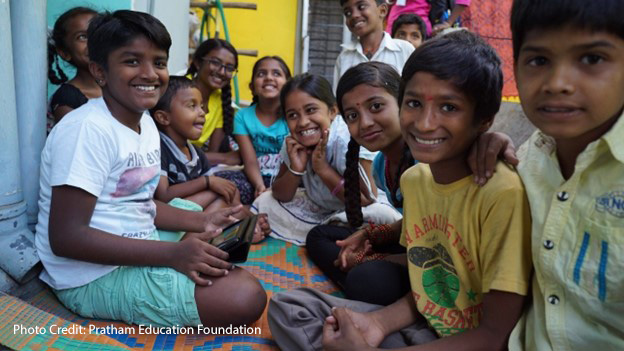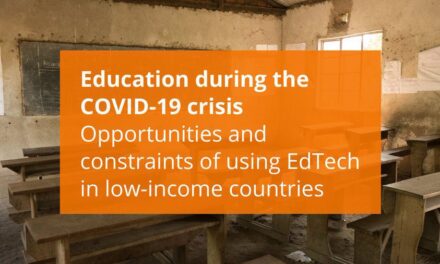This blog was written by Kriti Mahtab and Pupul Lama, Associates at Pratham Digital (part of Pratham Education Foundation).
With the advent of the digital revolution, the Indian education sector has witnessed a slow shift from the traditional blackboard-classroom setting to a more digitised learning environment. The reforms proposed under the National Education Policy 2020 emphasised the cultivation of 21st-century skills – like creativity, critical thinking, and digital literacy. This shift towards increased digitisation was accelerated exponentially by the COVID-19 pandemic which resulted in a series of nationwide lockdowns in 2020. Digital learning suddenly went from an optional supplement for the elite to an essential medium of formal education for all.
Prominent EdTech giants gained tremendously from this, quickly expanding their user bases, and making new acquisitions to expand their market share. However, the resources provided by these giants are often behind significant paywalls and mainly cater to privileged English-speaking students in big cities who already have access to high-speed internet and digital devices. The reality is that almost 50% of India’s students go to government schools that lack this infrastructure, and live in areas with very low digital penetration. Only 29% of government schools have functional computer facilities, and less than 12% have internet access. Smartphones, if accessible at all, are shared household items with limited availability of low-speed internet. This demographic was already under-resourced prior to the pandemic due to existing socio-economic inequalities. Increased reliance on EdTech platforms has widened this digital divide, further excluding marginalised learners and pushing many out of school permanently.
To ensure continuity of quality education, the government and local communities have the imperative challenge of equipping themselves with the requisite knowledge and expertise in EdTech to synthesise top-down and bottom-up approaches effectively.
Government capacity building
In July 2021, Education Minister Govind Singh Thakur, launched a phone donation campaign ‘Digital Saathi’ in Himachal Pradesh to provide under-resourced students with smartphones for remote learning. While moves like these are always welcome, the government must support the incorporation of EdTech not only through hardware solutions like computers, smart-TVs, and other devices but also through the provision of open-access learning platforms, and low-tech content (that consumes less data and takes up less memory space on devices), and teacher training.
A major step in this direction was the introduction of Diksha in 2017, the national digital infrastructure that hosts freely accessible learning resources from multiple national and state boards. It allows teachers to create and access in-class resources, teacher training content, and assessment aids online. During the pandemic, teachers and students were encouraged to use the platform for at-home learning. Diksha has a tremendous reach; the app itself has over 10 million downloads. However, simply providing a platform is not enough; the government also needs to build the capacity of educators and administrators to use it effectively. The uploading and reviewing process via Vidyadaan is notoriously convoluted, leaving even state administrators frustrated.
Most EdTech efforts are led by NGOs and private partnerships. The role played by them is varied; some play an advisory role in the creation of education policy, some collaborate with local and state governments to directly implement digital interventions, and some support the state’s creation of academic content. For instance, Avanti Fellows’ Sankalp programme in Haryana aims to empower teachers and students through computer-based video lectures and classroom-based peer learning activities. In their Ghar Pe School initiative, they collaborated with the government to create a digital library and platform for hosting live sessions to support at-home learning. Samagra, a governance consulting firm, works closely with the governments of Uttar Pradesh, Haryana, and Himachal Pradesh to improve learning outcomes and build state capacity in EdTech. Similarly, Pratham Education Foundation has helped map curriculum-aligned content for states like Himachal Pradesh, Uttarakhand, and Haryana to help build their digital content repositories, in addition to their direct digital learning interventions in 22 states.
While the government’s dependence on guidance from external partners is often necessary, there is a danger of this turning into over-reliance. It is imperative for local government officials to be actively involved in the interventions taking place in their communities in order to understand processes, failures, and successes directly from the educational experts from NGOs and private organisations. These officials are often also able to provide valuable insight into the local context and target demographics. In addition, government involvement can also add a layer of legitimacy that aids the success of digital interventions; Avanti Fellows’ RCT with J-PAL shows that government-mandated usage was a huge lever that drove engagement.
The main motivation behind government capacity building is creating ownership and thus ensuring the sustainability of initiatives. Government ownership over Edtech interventions not only allows the digital divide to be bridged to some extent but also ensures legitimacy and regional contextualisation through the use of familiar examples and vernacular languages.
Community capacity building
The schooling-from-home measure during the COVID-19 pandemic disproportionately affected the education and learning outcomes of children in rural India, leaving many out of school. It is reported that the most widely used EdTech products in rural households are WhatsApp and SMS-based learning, and television. However, access to quality remote learning is limited, primarily due to the absence of a robust digital infrastructure. This is further exacerbated by the harsh socio-economic realities and structures of the majority of rural households.
There is limited research available on the relationship between digitised learning and community development due to insufficient digital infrastructure in rural areas and its underutilisation. Nonetheless, the effective adoption of EdTech through comprehensive community capacity-building has the ability to reinforce a culture of learning among communities in low-tech areas of India and pave the way for greater access to education through digital innovations.
According to a report published by the Observer Research Foundation, the key factors inhibiting the effective transition to and adoption of EdTech in rural India are the scarcity of electricity and internet connectivity, girls having little or no access to smartphones, unaffordable internet data, low bandwidth of the internet in remote locations, and lack of government support. Compounded by the prevalent gender, socio-economic and cultural differences, and caste statuses, these characteristics further contribute to the ‘mystification’ of technology among rural communities.
To address this, it is necessary to realise and recognise the indispensable role of the community in children’s educational outcomes and holistic development. This can be achieved by applying community capacity building approaches that extend beyond local government teachers or administrators and directly involve community members.
For instance, introducing children to community-shared devices and providing a contextualised and localised digital repository carries the potential of facilitating an open learning environment and strengthening the social infrastructure within communities. In exchange, this allows trusted community members to lead EdTech interventions, which helps reverse the sceptical attitudes of parents and communities toward children using digital devices to access technology-aided learning resources rather than just communication and/or entertainment. This increases children’s access to technology-aided learning resources and improves the community’s involvement in and commitment to their children’s education. It is crucial to supplement the government efforts by reinforcing the existing capacities of the communities in initiating discourse and cooperation around EdTech.
Further, integrating community-driven capacity building not only supports children’s education in the long run but also those out-of-school and adult learners in acquiring useful skills and knowledge. By retreating from the typically privileged, restrictive, top-down knowledge-sharing and education models, the community capacity-building framework fosters leadership, problem-solving, decision-making, and self-reliance among rural communities, especially amongst adolescents and youth.
Way forward
As schools have re-opened, many believe that the disastrous effect of the pandemic on education is coming to an end. However, EdTech capacity building continues to be relevant for many children, like students facing significant learning loss after missing two years of schooling and those who will potentially not return to formal schooling at all. Efforts toward government and community capacity building are more important now than ever, to ensure that the progress made with digital interventions during the pandemic is leveraged effectively going forward. This is only possible through the collective and active involvement of the relevant stakeholders in establishing a robust digital infrastructure aiming for system-wide reform.






The digital revolution in Indian education must address the existing socio-economic inequalities. EdTech capacity-building in communities is crucial to bridge the digital divide. Focusing on government schools and areas with low digital penetration ensures inclusivity and access for marginalized learners. This approach aligns with the broader goal of fostering equitable education. #SchoolsInMagadiRoad #DigitalDivide #EdTechCapacityBuilding
Thank You
Mayank Jain
CEO Ezyschooling